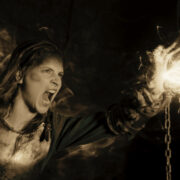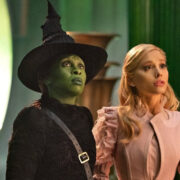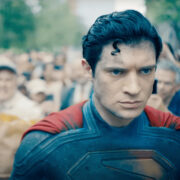Horrific Inquiry: SCREAM (1996)
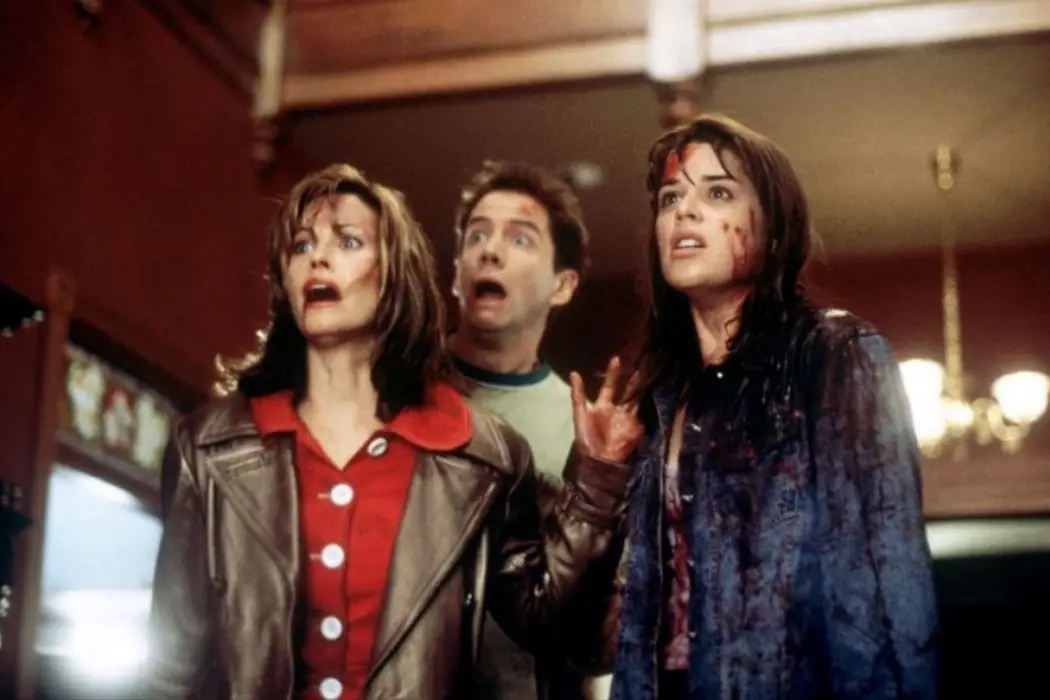
Stephanie Archer is 39 year old film fanatic living in…
Welcome back to the newest, and at times goriest, column here at Film Inquiry: Horrific Inquiry. Twice a month, I will be tackling all things horror, bringing two films back into the spotlight to terrify and frighten once more. And occasionally looking at those that could have pushed the envelope further. Join us as we dive deep into the heart of horror, but warning, there will be spoilers.
Today, we kick off the countdown to Halloween!
We all have that one horror film, that for whatever reason, just sticks with us. Myself, Scream is a favorite that has never, or will ever, waiver. For fear of dating myself, I was in fifth or sixth grade when Scream was released, a majority of my fellow students have already seen the horrifically graphic film in theaters. Still, a young horror cinephile limited mostly to the oddities and scares of classic Disney, Tim Burton, and a universally shared exposure to Poltergeist some years earlier, I was enamored with the horror each student relayed – the kills, the gore – the look in their eyes as they relayed their experience permanently ingrained in my mind. I longed to share in their experience, and while I was not initially allowed, it wasn’t long before I would join my fellow students.
Scream and I Know What You Did Last Summer (both written by the genius mind of Kevin Williamson) would be the first of many slashers to fill my time, their teenage horrors illuminating my screen and fully opening the door to the unlimited experiences the horror genre had to offer. And while horror has become a primary go-to over the years, Scream has always remained the shining beacon of horrific cinematic experiences and is a must-watch each Halloween season.
In honor of its upcoming 20th anniversary, Horrific Inquiry will be kicking off a Horrific cinematic countdown to the franchise’s fifth release in January, revisiting not only the original but the subsequent sequels that have defined not only a decade but have become a permanent induction within horror history.
Without further ado, let’s return to the birth of Ghostface in the quaint and quiet town of Woodsboro, CA…
Back to the Beginning
At the time of Scream’s release, Wes Craven was no stranger to the horror genre, having found previous successes with The Last House on the Left and undeniable career-defining A Nightmare on Elm Street. A masterclass in the slasher genre, Craven’s ability to wield the knife (in some cases knives) and camera were undeniable. With Scream, he revitalized the tired slasher sub-genre, infusing an audience with a renewed sense of discovery and originality, all while still honoring films of the past.
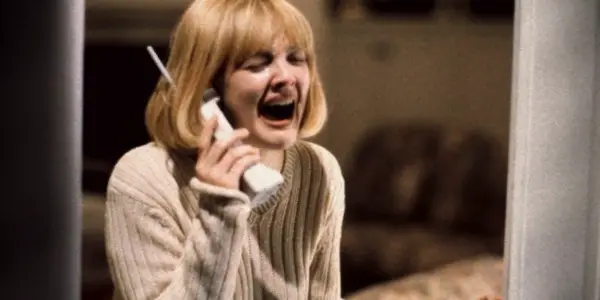
Scream demands your attention from its first few moments, a woman’s scream filling as the words “Scream” appear, the sound of a phone ringing transitioning to the film’s opening. In an instant, Scream solidifies its terrifying modernization, the ringing a “wrong number” that becomes the terrorizing catalyst to the horrific and gruesome murders of both Casey (Drew Barrymore) and Steve (Kevin Patrick Walls). “What’s your favorite scary movie” is transformed not into a conversational opening, but a tantalizing crumb trail to death. As the phone continues to ring, the tension increases, the hairs on your arm standing on end as the malicious game is unveiled, and the presumed safety of Casey’s home is peeled away piece by piece.
The construction of Scream’s opening is brilliant. While it modernizes the traditional slasher, it’s also effective in laying out its killer and unpredictability of narrative. Taking a note from Alfred Hitchc*ck’s Psycho, Drew Barrymore’s Casey does not survive long in the film, the graphic nature of her murder instantly becoming a pop culture reference for years to come. But it is not just the early loss of one of the film’s biggest names early on, but the almost superhuman nature that’s infused within Ghostface.
Building Credible Characters and Narrative
Following the film’s opening sequence, audiences are brought into the bedroom of Sidney Prescott (Neve Campbell) and the Woodboro High School as both the foundation of each of the characters is presented. Sidney is emotionally recovering from the devastating murder of her mother, an element of her character the film leans into bit by bit. Her trauma is not immediately revealed, but rather inferred, giving Sidney a lure of mystery and a well of depth early on. The characters surrounding Sidney are also given platforms to shine and grow beyond the traditional supporting roles of upping the body count.
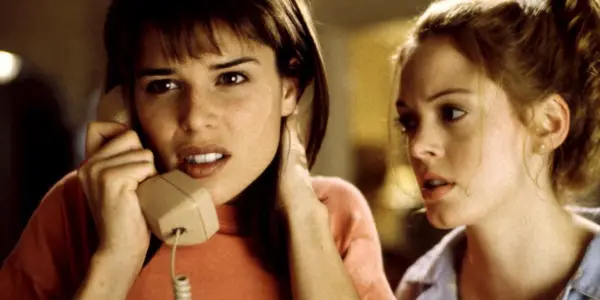
While some are given more depth than others, their interlacing storylines and interactions build the film’s narrative to its success. The murder of Sidney’s mother plays deep into the motivations and outcomes of the film, her death perpetrated and pushing the decisions and actions of many of the film’s characters. As it is revealed, Billy (Skeet Ulrich) and Stu (Matthew Lillard) murdered Sidney’s mother, framing Cotton Weary (Liev Schreiber) for the vicious slaying. As they torment Sidney, taking each of her friends, and their own personal revenge, one by one before the film’s climactic massacre, her mother’s murder is constantly brought back to the forefront.
Both narrative and character find their strength in the individuals behind them. Written by the brilliant Kevin Williamson, Scream was not the original film he wanted to have made, but it would become his most successful. The wit and tightly constructive horror narrative perfectly encapsulate the terror beset on Woodboro and its characters, leaving little questionability and error in its wake. Wes Craven brings his script to life with a masterclass hand of skill, creating a slasher that would define a generation.
Furthering its success is the film’s actor, Neve Campbell joining the ranks of Final Girls before her. Scream would be a defining moment in Campbell‘s career, one that would reign supreme over the course of four films – and soon to be a fifth. Here, there is a tormented soul trapped in the inability to move forward from the grief of her mother’s death. Campbell balances Sidney’s grief and fear, allowing her character room for growth as the terror continues to grow.
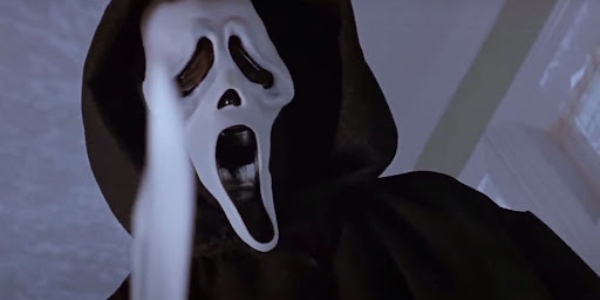
Contrasting her vulnerability, Billy, Stu, and Courteney Cox as Gail Weathers each bring their own confidence that builds the narrative and tension and keeps the audience guessing. Cox completely captures the ambition and lack of morality that has made Gail’s career successful. Her in-your-face performance gives the film a strong female lead that refuses to take no for an answer. Ulrich and Lillard also exude confidence, one that keeps the truth right beneath the surface. As they toy with the audience through exchanged looks, they know the truth we are forced to wait patiently for. Their chemistry and strength make Stu and Billy unforgettable killers within the genre.
The Rules to Survive a Horror Film
While the film thus far sounds incredible, it is not just script and screen that boast its success. Scream almost breaks the fourth wall, winking at the audience while it acknowledges aloud what the audience has known of the genre for years all while referencing the horrors we love and critique. It is what really makes the film unique – its ability to make fun of itself.
From the opening scene, as the killer asks Casey for her “favorite scary movie”, classic horror films of the past are relayed (including Craven’s A Nightmare on Elm Street), the game enacted by the killer involving the killer of the original Friday the 13th. There is an awareness of the film’s nature and an acknowledgment of the genre itself. As Tatum (Rose McGowan) relays the gruesome murders of Casey and Steve to Sid, she emphasizes that this is not an ordinary killing but rather one of those “splatter movie killed” murders. As the murder and the horror continue to play out, the characters even acknowledge that “it’s like a horror movie or something”.
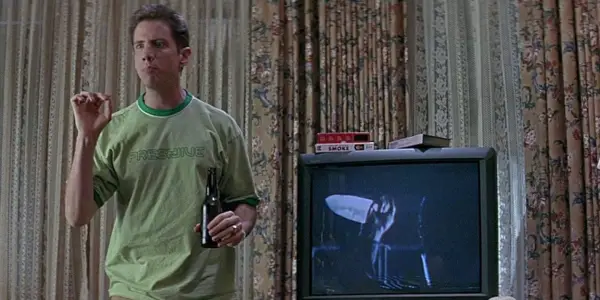
Scream is not afraid either of calling the genre out for its depictions of women in the past and the cliché moments viewers have come to expect when watching a horror. When the killer first calls Sid, she calls out horror films – “some stupid killer stalking a big breasted girl that can’t act, who’s always running up the stairs instead of running out the door – it’s insulting“. This is further expanded, Sidney attempting to run out the front door as the killer descends on her, the chain lock preventing her escape. Later on in the film, she will also have no choice but to run up the stairs to Stu’s family attic.
Scream also looks for any opportunity to reference horror classics of the past. Billy is “branded the Candyman”, a scene within the video store that lends to a variety of horror titles, Billy reminds audiences “we all go a little mad sometimes” and a brilliant cameo from Wes Craven brings audiences face to face with a janitor dressed as Freddy Krueger. The references are unrelenting and deliciously interlaced.
But what Scream does best with its nods to horror and awareness of the horror clichés is through the use of Randy (Jamie Kennedy), horror fanatic extraordinaire whose knowledge of the genre saves the gang time after time (sequel after sequel – but we will get to that). As the party is reaching its climax, Randy spurs out the rules to survive a horror film. You can never have sex, you can never drink or do drugs, and you can never say “I’ll be right back”. These rules shape both a horror film and its outcomes – specifically, its survivors. While Scream acknowledges these rules, it also evolves beyond them. Sidney violates the rules of a horror film, specifically the sex rule – and survives. Randy is seen drinking, almost to his demise, but he survives to see the sequel as well. While the film’s characters can not pick their horror film, they can break the rules, pushing the genre into new and unexplored territory.
Conclusion: Scream
Scream continues to be one of the many faces of the slasher era, but more so a horror film whose awareness would challenge horror films to be more than what audiences expected them to be. An undeniable influence in pop culture, Scream would continue to horrify for decades to come. With three sequels and a TV series to follow, and a fifth film on the horizon, Scream has proven itself to be a staple of a genre and an undeniable part of horror cinematic history.
Next Month, the Horrific Inquiry Scream countdown returns with Scream 2! For now, check back next week as our Halloween countdown continues!
Watch Scream
Does content like this matter to you?
Become a Member and support film journalism. Unlock access to all of Film Inquiry`s great articles. Join a community of like-minded readers who are passionate about cinema - get access to our private members Network, give back to independent filmmakers, and more.






